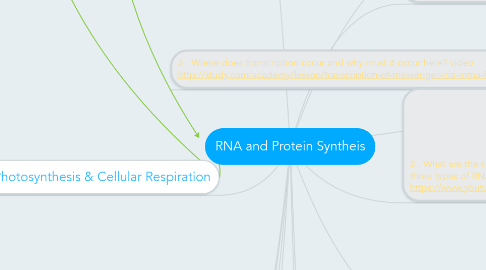
1. 3 . Where does transcription occur and why must it occur here? video http://study.com/academy/lesson/transcription-of-messenger-rna-mrna-from-dna.html
2. 5 What is the end product of translation? image :
3. 6 . What enzyme is responsible for a copy of RNA made from DNA? image :
4. 7 . What is the term for a nucleotide triplet?
4.1. codons
5. 8 . Transcribe and translate the mRNA strand: CGAUGGGAUCGUUAGCUAGCAGCUAGCG
5.1. GCTACCCTAGCAATCGATCGTCGATCGC
6. 11 . What could be the result of a mutation? Are all mutations detrimental (bad)? image :
6.1. no not all mutations are bad , they are either strickly harmful ,strickly helpful , or neautral
7. Photosynthesis & Cellular Respiration
7.1. 21 . What is the equation for photosynthesis? image :
7.2. 22 . Where does photosynthesis take place?
7.2.1. Photosynthesis takes place inside plant cells in small things called chloroplasts image :
7.3. 23. What are the two parts of photosynthesis? image :
7.4. 24 . Where does each of the processes above occur?
7.4.1. light dependent reactions :thylakoid membranes
7.4.2. independent reactions /calvin cycle : stroma of the chloroplasts
7.5. 25 . How are these two processes in photosynthesis related and dependent on one another?
7.5.1. Related : Light dependent reactions produce ATP and NADPH which are both neccessary for the calvin cycle .
7.5.2. Different : light dependent reactions happen in the thylakoid membrane and independent reactions occur in the stroma
7.5.3. independent reactions uses the ATP and NADPH which dependent reactions produce .
7.6. 26. What is the equation for cellular respiration? image :
7.7. 27 .What are the parts of cellular respiration?
7.7.1. video : https://www.youtube.com/watch?v=hZUc5KndgyE
7.8. 28 . What part of cellular respiration could not occur if there was no oxygen present? What would happen instead?
7.8.1. Cellular respiration can occur without oxygen , it is known as anaerobic .
7.9. 29 . How are photosynthesis and cellular respiration related?
7.9.1. Photosynthesis is the process whereby carbon dioxide and water react, using energy from sunlight, to produce glucose and oxygen. In cellular respiration, the glucose combines with oxygen to produce carbon dioxide.
7.10. What molecule represents energy produced in cellular respiration?
7.10.1. ATP
7.11. What molecule represents energy produced in cellular respiration?
7.11.1. sunlight
8. Cells and Biochemistry
8.1. 32 . What are the levels of organization? Explain each level and how it differs from the others
8.1.1. Atom : basic unit of matter
8.1.2. Molecules : group of atoms held together by bonds
8.1.3. Organelle: structure within cell that performs specific functions
8.1.4. Cell ; most basic unit of life
8.1.5. Tissue : group of similar cells that perform a specific function
8.1.6. Organ : a structure of several types of tissue that form a functional unit
8.1.7. Organism : independent living thing
8.2. 33. What is the smallest level of organization that can perform life functions?
8.2.1. Atoms/ image :
8.3. 34 . What are the characteristics of life? Give an example of each.
8.3.1. Made of one or more cells : organisms
8.3.2. Displays organization: anteater’s snout
8.3.3. Grows and develops : bullfrog tadpole grows up to a frog
8.3.4. Reproduces : humans reproduce by having children
8.3.5. Responds to stimuli : gazelle running away from a hungry cheetah
8.3.6. Requires energy : a squirrel eats berries
8.4. 35 . Explain how a rock cannot be considered alive.
8.4.1. Rocks can be considered not alive because it doesn’t maintain any of the characteristics of life .
8.5. 36 .What is a monomer?
8.5.1. A monomer is a molecule that can be bonded to other identical molecules to form a polymer. image :
8.6. 37 . What is a polymer?
8.6.1. A polymer is a substance that has a molecular structure consisting chiefly or entirely of a large number of similar units bonded together / image :
8.7. 38 . What is the reaction that forms polymers?
8.7.1. Condensation or dehydration synthesis
8.8. 39 .What is the reaction that breaks polymers?
8.8.1. Hydrolysis
8.9. 40 .What are the four types of biological molecules (macromolecules) discussed in class?
8.9.1. .
8.9.1.1. Carbohydrates , lipids , proteins , and nucleic acids .
8.10. 41What are the monomers for each of the types of biological molecules listed above?.
8.10.1. Carbohydrates - monosaccharides. Lipids - glycerol and fatty acids. Nucleic acids - nucleotides. Proteins - amino acids.
8.11. 42 .Explain the importance of surface area to volume ratio for a cell.
8.11.1. The important point is that the surface area to the volume ratio gets smaller as the cell gets larger. Thus, if the cell grows beyond a certain limit, not enough material will be able to cross the membrane fast enough to accommodate the increased cellular volume
8.12. 43 . Which cell would be most efficient at absorbing nutrients? A cell with a 8:1 surface area to volume ratio or a cell with a 5:1 surface area to volume ratio? Why?
8.12.1. A cell with a 5:1 ratio because as the surface area to the volume ratio gets smaller
8.13. 44 Which elements (types of atoms) are found in abundance in living organisms? .
8.13.1. Hydrogen , nitrogen , carbon , and oxygen .
8.14. 45 Which element is important when considering if something is “organic”?.
8.14.1. carbon

